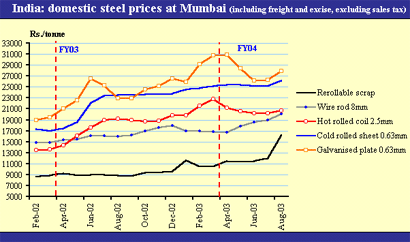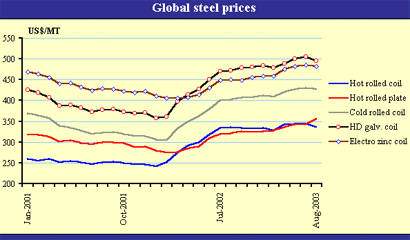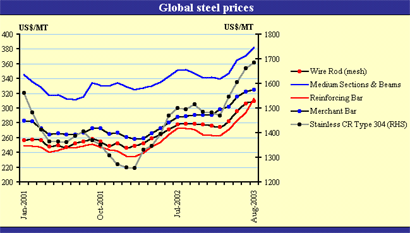Pricing trends
01 Jan 1900
Fiscal 2002-03 was witness to the most dramatic upward movement in steel prices. Though there was a plateauing in the pricing trend line of both hot rolled (HR) coils and cold rolled (CR) coils between February and June this year, the prices have gone back to the levels that existed at the start of the year.
The steel industry has not had it this good. Thanks to the sharp focus on costs and the need to reduce overheads that the downturn in prices brought during 2001-02, the jump in prices later became a leap for steel companies'' bottomlines. The big rise in Tata Steel''s profits and the turnaround of Steel Authority of India (SAIL) are examples of the beneficial effect that the price increases have had on profitability.
However, steel prices during the first few months of this year have been extremely volatile. Steel manufacturers who were rejoicing the sustained price levels in the export markets were jolted by the sudden, sharp fall, by nearly 30 per cent, in HR prices within a short span of four months. Between February and June, the prices of HR steel fell from a peak of $350 per tonne to about $250. The prices of CR steel fell by a smaller 18 per cent. While the volatility in steel prices is likely to continue, the industry expects them to stabilise by the year-end.

Analysts say that the steel industry world-wide is immune to periodic downturns in steel prices. Therefore, the recent price drops resulting mainly from excess speculative bookings from China need not affect long-term profitability.


The same level of optimism regarding the price trend is reflected by industry sources. They say that steel prices have been subjected to five cycles since 1995. Currently, they are on an up tick led by growth in demand and consumption in China. There may be marginal dips from here but this will be temporary. This phase will give opportunity to the domestic market to adjust its demand and supply mismatch witnessed earlier.
With equilibrium in steel demand and supply will come stability in steel prices. The current global over-capacity in steel production is expected to even out slowly. OECD countries have identified 140 million tonnes of unviable steel capacity to be phased out over the next two years.
Similarly, the proposed merger of three large steel companies in the US could lead to a rationalisation of steel manufacturing capacities in that market.
However, these developments could be delayed owing to political compulsions in those countries.













.jpg)






.jpg)









